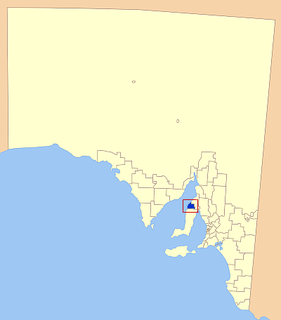
The Mid Murray Council is a local government area in South Australia in the Murray and Mallee region of South Australia. The council spans the area from the Riverland through the Murraylands to the eastern slopes of the Mount Lofty Ranges. It includes 220 km of the Murray River. The council seat is at Mannum; it also maintains secondary offices at Cambrai and Morgan.

Northern Areas Council is a local government area in the Yorke and Mid North region of South Australia. The council seat and main council offices are at Jamestown, while the council also maintains district offices at Gladstone and Spalding.

Laura is a rural town in the Mid North region of South Australia, 12 km north of Gladstone on the Horrocks Highway and 40 km east of Port Pirie. The first European to explore the district was Thomas Burr in September 1842. His promising reports soon led to occupation of the district by pastoralists, one of whom was Herbert Bristow Hughes. When the present town was surveyed he named it for his wife, Laura née White.

The Copper Coast Council is a local government area in the Australian state of South Australia located at the northern end of the Yorke Peninsula. It was established in 1997 and its seat is in Kadina.

Georgetown is a town in the Mid North region of South Australia. The town is in the Northern Areas Council, 196 kilometres (122 mi) north of the state capital, Adelaide on the Horrocks Highway. At the 2006 census, Georgetown had a population of 119.

Wirrabara is a town and a locality in South Australia. Wirrabara is located in the Southern Flinders Ranges in the Mid North of South Australia, along the Rocky River. The Horrocks Highway passes through the town.
Rocky River was an electoral district of the House of Assembly in the Australian state of South Australia from March 1938 to December 1985.

The District Council of Spalding was a local government area in South Australia, centred on the town of Spalding. It was proclaimed on 30 July 1885 by Governor William C. F. Robinson, comprising the Hundreds of Reynolds and Andrews as far south as the northern boundary of Euromina. It followed significant agitation by residents for a local municipality, with the boundaries having been the subject of some dispute.
The District Council of Hutt and Hill Rivers was a local government area in South Australia. It was established on 30 July 1885 and included the entirety of the Hundred of Milne as well as the south half of the Hundred of Andrews. It gained the Hundred of Hart in January 1888 following the passage of the District Councils Act 1887. The municipality had no township within its boundaries, so a council chambers was built at Bungaree; the building survives today and is used for tourist accommodation. In 1909, a section was severed and added to the District Council of Snowtown. It was abolished in 1935 following a Local Government Commission report that advocated cutting the number of municipalities in South Australia from 196 to 142, with Hutt and Hill Rivers being divided between the adjacent District Council of Spalding, District Council of Clare and the remainder to the District Council of Blyth.
Narridy is a locality in the Mid North region of South Australia, situated within the Northern Areas Council.

The District Council of Light was a local government area in South Australia from 1977 to 1996, seated at Freeling.
The District Council of Crystal Brook was a local government area in South Australia from 1882 until 1988, seated at Crystal Brook.

The District Council of Crystal Brook-Redhill was a local government area in South Australia.

The District Council of Booyoolie was a local government area in South Australia. It was proclaimed on 2 March 1876 and comprised the entire cadastral Hundred of Booyoolie. It included at its inception the government town of Booyoolie, North Gladstone, Laura and Stone Hut. It was divided into five wards, each electing one councillor. In September 1876, the council decided to construct a council office and chamber at Laura.
The Corporate Town of Gladstone was a local government area in South Australia, centred on the town of Gladstone. It was proclaimed on 8 March 1883, separating the township from the surrounding District Council of Gladstone. It was divided into three wards at its inception, each represented by two councillors. In 1923, it covered an area of 2,243 acres, with a capital value of £137,740. In 1924, it transferred ownership of the Town Hall and the Soldiers' Memorial to the Gladstone Institute. It ceased to exist on 15 May 1933 when it merged back into the District Council. It was expressed at the time that there was local regret at the loss of the distinct town council, but that a decline in rates and reductions in state government expenditure had made it a necessity.

The District Council of Northern Yorke Peninsula was a local government area in South Australia from 1984 to 1997. The council seat was at Kadina.

The Hundred of Yackamoorundie is a cadastral unit of hundred in the County of Stanley, South Australia.









